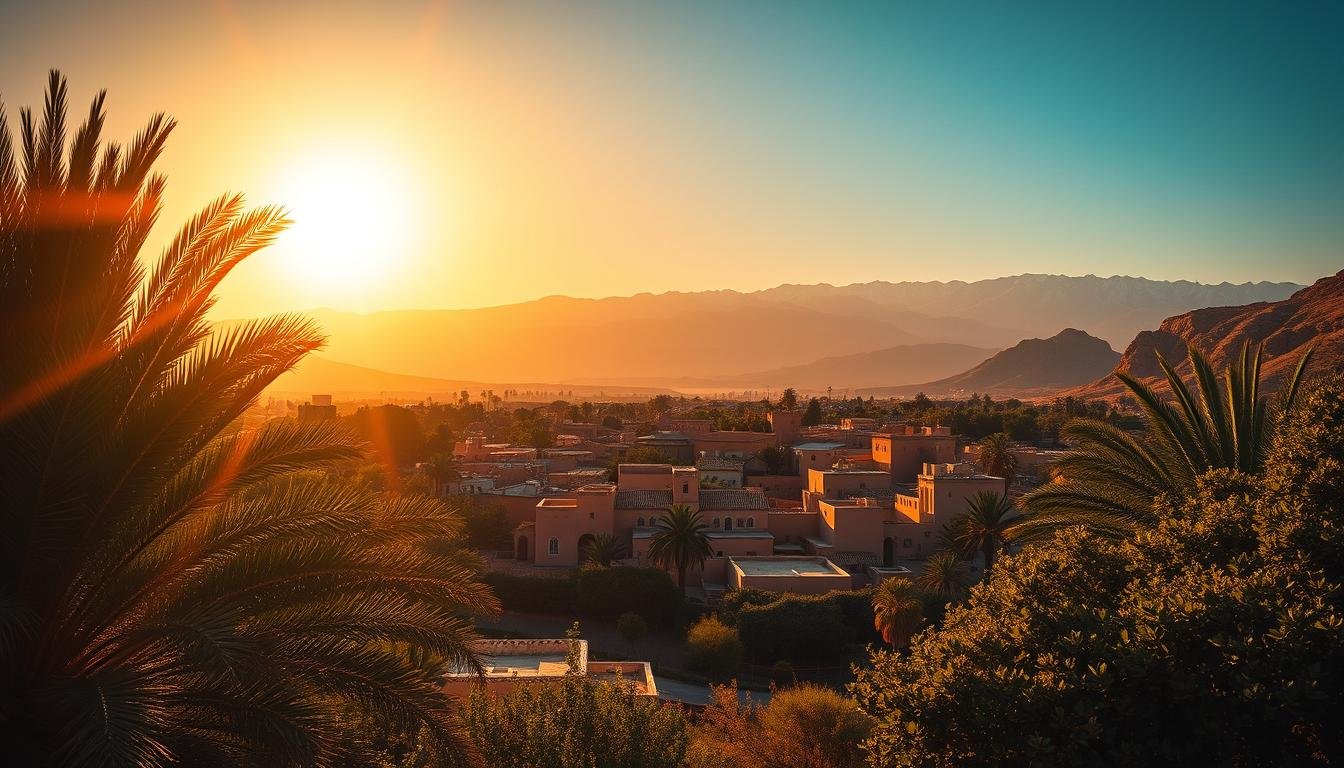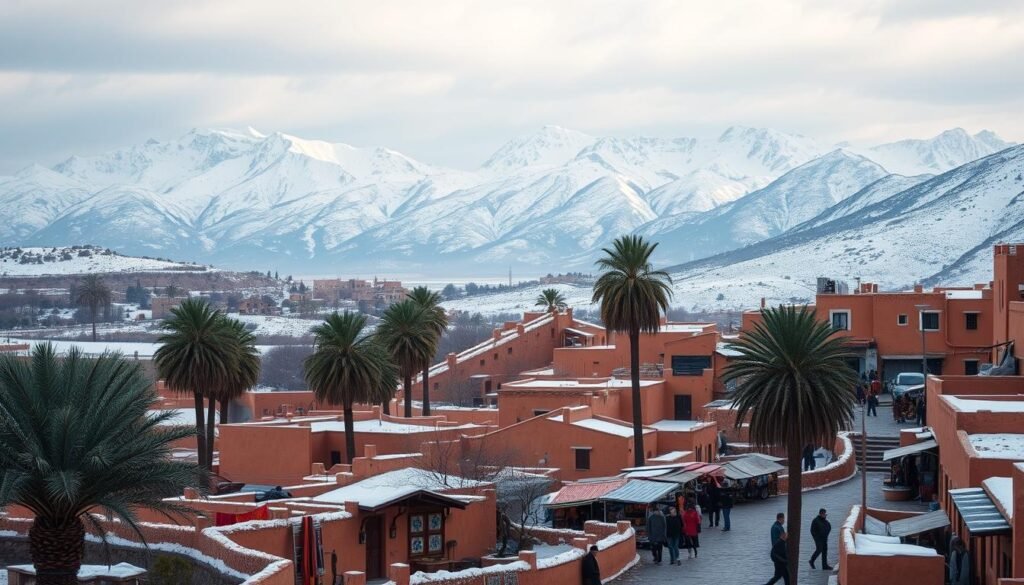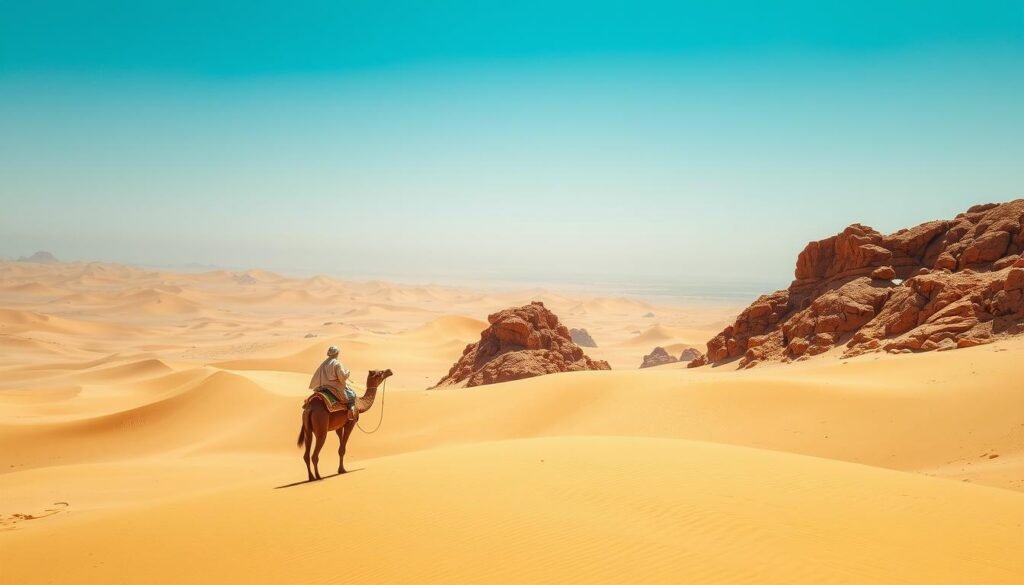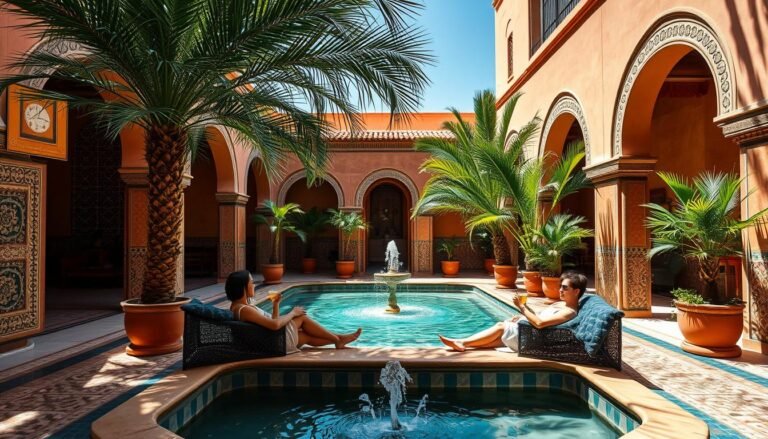Best Time to Visit Morocco by Region & Season

Every year, over 8 million tourists flock to Morocco. This North African gem has something for everyone. But, the perfect time to see its cities, mountains, and coasts changes with each region.
Planning your Moroccan adventure can be tricky. The country’s climate is diverse. So, the best time to visit Morocco varies by region.
Key Takeaways
- Morocco’s climate varies greatly across different regions.
- The ideal time to visit depends on your itinerary.
- Understanding the local climate is key to a successful trip.
- Morocco offers fantastic destinations year-round.
- Regional climate differences can significantly impact your travel plans.
Understanding Morocco’s Climate
To enjoy your trip to Morocco, knowing the climate is key. The country’s varied geography, with mountains, deserts, and coastlines, shapes its weather. These include the Atlantic Ocean and Mediterranean Sea.
Morocco’s Four Distinct Seasons
Morocco has four seasons: spring, summer, autumn, and winter. Each season offers unique weather and experiences. Travelers say the country’s climate diversity means there’s always something new to discover, no matter the season.
Spring (March to May) and autumn (September to November) are the best times to visit. They have mild temperatures and fewer tourists.
Regional Climate Variations
The climate in Morocco changes a lot from one place to another. Coastal areas are milder than inland, where temperatures can swing a lot. The Atlas Mountains get snow in winter, while the Sahara Desert is very hot during the day and cold at night.
How Weather Affects Your Travel Experience
The weather can really change your travel plans in Morocco. The dry and warm periods are best for desert and mountain explorations. But, the rainy season can make some places hard to reach.
Knowing these climate differences helps you pack right and plan your trip better.
When is the Best Time to Visit Morocco?
The best time to visit Morocco depends on what you want to do. Each season has its own charm and benefits. Knowing the climate and seasons helps plan your trip better.
Peak Season
The peak tourist season in Morocco is spring (April-May) and autumn (September-October). These months have nice weather and fewer people than summer. September is a favorite for its perfect weather and the chance to enjoy beaches and mountains.
Off-Peak Advantages
Visiting Morocco in the off-season (November-March) has its perks. You’ll find cheaper hotels and fewer tourists. It’s cooler, but the south, like Marrakech, is mild and inviting.
Summer Considerations
Summer (June-August) is very hot in Morocco, with desert temperatures rising. Coastal and mountain areas are cooler. If you visit in summer, head to the mountains or enjoy summer festivals.
UK Travel Patterns and Flight Availability
Flights from the UK change with the seasons. Peak times have more flights but cost more. Off-peak is cheaper. Booking early gets you better deals, no matter when you go.
When planning your Morocco trip, think about what you want to see. Morocco offers something for everyone, whether you like busy markets or quiet landscapes.
Spring in Morocco: March to May
Spring in Morocco brings mild temperatures and a burst of natural beauty. The country’s landscapes become vibrant, making it perfect for exploring.
Weather Patterns and Temperatures
Spring in Morocco has pleasant weather, with highs from 20°C to 25°C (68°F to 77°F). It’s great for sightseeing and outdoor fun. You’ll enjoy lots of sunshine and mild evenings perfect for local cuisine and culture.
Best Regions to Visit in Spring
Marrakesh is wonderful in spring, with sunny days and comfy temperatures. The Atlas Mountains are stunning, with wildflowers and lush greenery. Coastal spots like Essaouira offer a cool break with their beaches.
Spring Festivals and Events
Morocco hosts many festivals in spring, like cultural and music events. The Marrakech Popular Arts Festival is a must-see, celebrating local arts. Don’t miss the Essaouira Gnawa Music Festival for its lively vibe.
Wildflower Blooms and Natural Beauty
Spring in Morocco is famous for its wildflower blooms, mainly in the Atlas Mountains and rural areas. The scenery is breathtaking, perfect for hiking and photography.
Summer in Morocco: June to August
Summer in Morocco is hot, but it’s also a time for amazing cultural experiences. The heat makes the landscape change, giving visitors a special view of this North African country.
Managing the Heat in Cities
Cities in Morocco get very hot in summer. To stay cool, visit shaded riads or go out early or late. “Staying hydrated and planning your days is key,” says a local expert.
Coastal Retreats and Mountain Escapes
The coast is a cool escape from the heat. Essaouira and Agadir are great for a break. The Atlas Mountains offer cooler weather and stunning views, perfect for hiking and visiting Berber villages.
Summer Cultural Experiences
Summer is perfect for outdoor music and festivals, like the Fez Festival of World Sacred Music. These events highlight Morocco’s culture, with traditional music, dance, and food in a lively setting.
Ramadan Considerations
Ramadan might fall in summer, so respect the fasting. Restaurants close during the day, and be aware of local customs. But, Ramadan evenings are festive, with great food and atmosphere.
Summer travel in Morocco needs planning, but it’s worth it. You’ll get to see the culture, landscapes, and hospitality at their best.
Autumn in Morocco: September to November
Morocco in autumn is a mix of nice weather, cultural events, and fun experiences. The summer heat fades, making the country a cozy place for visitors.
Perfect Weather Windows
Autumn brings mild temperatures, perfect for exploring Morocco. The sun shines, with highs from 25°C to 30°C (77°F to 86°F) in September and October. This weather is great for hiking in the Atlas Mountains or wandering through Marrakech’s souks.
Harvest Season Experiences
Autumn is harvest time in Morocco, a chance to see the country’s farming traditions. You can help with grape picking in the Atlas Mountains or join the olive harvest in Meknès. These activities give a peek into Moroccan farming and let you taste fresh local foods.
Autumn Festivals and Events
Morocco has many festivals and events in autumn. The Marrakech International Film Festival is a big draw for film lovers. Also, the Eid al-Mawlid celebrations, marking the Prophet Muhammad’s birth, often happen in autumn. They offer a look into Morocco’s culture and faith.
Reduced Crowds and Better Rates
Visiting Morocco in autumn means fewer tourists than in summer. This means better deals on places to stay and tours. With less people, popular spots feel more peaceful, giving a truer experience.
Autumn in Morocco is a great time to see the country’s varied landscapes, dive into its culture, and enjoy the weather. Whether you’re into history, nature, or just want to see a new place, Morocco in autumn has lots to offer.
Winter in Morocco: December to February
Morocco in winter is a mix of snow in the mountains and warm coastal towns. You can enjoy mild weather by the sea, feel the excitement of snow in the mountains, and explore cities without the crowds.
Mild Coastal Winters
Cities like Essaouira and Agadir have mild winters. They are great for those who want to escape cold European winters. You can go to the beach, check out local markets, and try fresh seafood.
Mountain Snow and Desert Nights
The Atlas Mountains are perfect for skiing and snowboarding. The desert nights are cool, making them great for stargazing.

Winter Cultural Immersion
Winter is a great time to dive into Moroccan culture. You can visit busy souks, historical sites, and enjoy festivals without the crowds. The cities are filled with Christmas and New Year celebrations.
Holiday Season Travel Tips
Book your stay and tours early for the winter holidays in Morocco. Pack layers because it gets cold at night, even in the desert and mountains.
Regional Guide: Northern Morocco
Northern Morocco is a treasure trove of culture and landscapes. It’s where Mediterranean and African cultures meet. You’ll find historic cities and breathtaking natural beauty.
Tangier, Chefchaouen, and the Mediterranean
Tangier is a lively port city, and Chefchaouen is a charming town in the Rif Mountains. Both are highlights of Northern Morocco. You can wander through vibrant markets, see historic sites, and soak up the laid-back vibe. The Mediterranean coast has stunning beaches and views.
Best Months for Northern Exploration
The best time to see Northern Morocco is in spring (March to May) and autumn (September to November). The weather is mild, between 15°C and 25°C (59°F to 77°F). It’s perfect for city tours, hiking, and outdoor fun. Here’s why you should visit then:
- Mild weather, perfect for sightseeing
- Fewer tourists compared to peak summer months
- Rich cultural events and festivals
Seasonal Events and Festivals
Northern Morocco has many cultural events and festivals all year. You can catch the Tangier International Film Festival and the Chefchaouen Cultural Festival. These events offer a glimpse into the local culture through music, art, and traditions.
Regional Guide: Atlas Mountains
Exploring the Atlas Mountains reveals a mix of natural beauty and cultural heritage. This area is a year-round spot, with different activities and experiences by season.
Hiking Seasons in the High Atlas
The High Atlas mountains are great for hiking in spring (April to June) and autumn (September to November). The weather is mild and pleasant during these times. It’s the ideal time for trekking, with beautiful views.
Winter Sports Opportunities
The Atlas Mountains are perfect for winter sports from December to March. Places like Oukaïmeden have slopes for all skill levels. It’s a great place for skiing and snowboarding.
Mountain Villages and Berber Culture
The Atlas Mountains have many Berber villages. Here, you can see the rich culture of the area. Visiting these villages lets you see traditional Berber life and meet the locals.
Whether hiking, skiing, or exploring villages, the Atlas Mountains are unforgettable. With its varied landscapes and rich culture, it’s a key place to visit in Morocco.
Regional Guide: Southern Morocco and the Desert
Marrakech, Ouarzazate, and the Sahara Desert are key parts of Southern Morocco. They offer a unique travel experience. You’ll find vibrant culture, stunning landscapes, and adventure here.
Marrakech, Ouarzazate, and the Sahara
Marrakech is famous for its lively souks and rich history. Ouarzazate is called the “Gateway to the Sahara.” It shows the desert’s beauty. The Sahara Desert is perfect for those who love adventure, with its vast dunes and calm landscapes.

Desert Travel Timing
The best time to see the Sahara Desert is in spring (March to May) and autumn (September to November). These times have better weather for exploring and camping under the stars.
Avoiding Sandstorms and Extreme Heat
To dodge sandstorms, check the weather before going into the desert. Traveling early morning or late evening helps with the heat. Don’t forget to bring sunscreen, a hat, and sunglasses for protection.
Stargazing Opportunities
Stargazing in the Sahara Desert is magical. The clear skies show amazing star views. Many tours offer stargazing packages, making it easy to see this wonder.
Regional Guide: Coastal Morocco
Essaouira, Agadir, and other coastal towns in Morocco are famous for their stunning beaches and steady surf. These areas offer a mix of cultural experiences and outdoor fun. They are a top spot to visit.
Essaouira, Agadir, and the Atlantic Coast
The Atlantic coast of Morocco boasts some of its most lovely beach towns. Essaouira is known for its walls and lively arts scene. Agadir is famous for its gorgeous beaches and water sports. You can try fresh seafood, check out local markets, and unwind on the beach.
Beach Season Planning
The best time for beach fun in Coastal Morocco is from April to October. The weather is warm and sunny during this time. You can swim, sunbathe, and try water sports. For a calmer vibe, visit in the shoulder season (April-May or September-October).
Surfing and Water Sports Timing
Coastal Morocco is a dream for surfers with its steady waves. The best surfing months are from September to April. Kitesurfing and paddleboarding are also big hits in the area.
Coastal Festivals and Events
The coastal towns of Morocco have many festivals and events all year. The Essaouira Gnawa Music Festival in June is a big deal. It showcases traditional Gnawa music and cultural shows. Other events include the Agadir International Festival and seafood festivals.
Practical Travel Tips for Every Season
Traveling to Morocco can be smooth and fun if you’re ready for the year’s changes. Whether you visit in the busy season or the quiet months, knowing what to expect helps a lot.
Packing Essentials by Season
Morocco’s weather changes a lot by season and place. In spring and autumn, you’ll need layers for the cool mornings and evenings. For summer, pack light, airy clothes. And in winter, the mountains can be chilly, so bring warm clothes.
Spring (March to May): Pack light layers for the cooler mornings and evenings. Also, remember to use sunscreen as the sun gets stronger.
Summer (June to August): You’ll need light, airy clothes. Don’t forget a hat and sunscreen to stay cool.
Budget Considerations Throughout the Year
Traveling to Morocco can save you money if you plan right. Prices go up in the busy seasons (April-May and September-October). But, the quiet months offer cheaper deals on places to stay and tours.
Ramadan Travel Advice
Knowing about Ramadan is key for a trip to Morocco. During Ramadan, many places to eat are closed during the day. But, it’s a great time to see Moroccan culture, with lively nights and special events.
Tip: Dress modestly and be kind to those fasting during Ramadan.
UK to Morocco Travel Logistics
Getting to Morocco from the UK is easy, with many flights to cities like Marrakech and Casablanca. Booking early can get you a better price. Also, the time of year affects flight costs.
Conclusion: Planning Your Perfect Moroccan Adventure
Morocco is a unique place to visit all year round. Knowing when to go is key to a great trip. You can explore cities, relax on beaches, or trek mountains, depending on your interests.
The best time to visit Morocco varies by region. Spring and autumn are usually the best months for good weather. For desert or beach trips, summer is great for the coast, and winter for cooler desert days.
By picking the right time and places, you’ll make memories in Morocco. Start planning your trip now and see the wonders Morocco has to offer.

